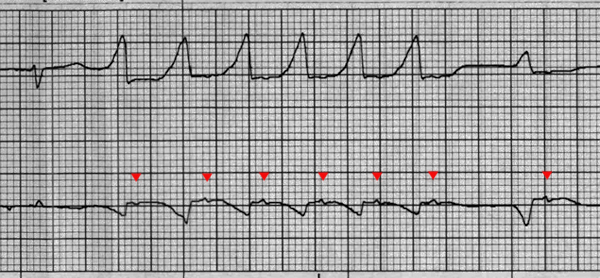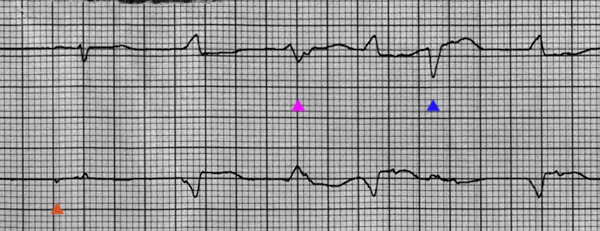runs of wide complex tachycardia
First Glance:
From across the room it looks like an irregular supraventricular rhythm interrupted by a run of VT.
Discussion:
If this is the first 10 seconds of monitoring, you might not need coffee. The upper lead is II at a gain of 40%, and the lower lead is ‘V’ at 40%.
Let’s start with the upper lead (II) where we start out with an odd looking beat 1, then three roughly identical beats that are narrow. The rate is irregular and slow. Then at beat 5 begins a 6 beat run of a wide complex regular rhythm @ ~160 bpm with a completely different axis than the prior beats. There are tiny deflections between these beats that are consistent with P waves. So maybe this is a run of AT?
Let’s look closely at the first run:

We can see the little P wave deflections associated with every beat (red triangles).
Then we get three wide beats of varying amplitude but similar morphology (ventricular beats?) followed by another odd one that looks like a combination of the first supraventricular beats and the later wide beats. Looks like a fusion beat, right? Then we get five more fast beats that are almost regular @ ~125 bpm that are narrower and smaller than the prior run, but look morphologically similar to the prior wide run. I see similar tiny P waves in between the beats, but now with a longer PR interval.
Here’s a closer look:

On close inspection, it looks like the P waves seem to follow the QRS complexes here, and if you compare to the first run- the QRS to P interval is the same. Further inspection of both runs shows no P waves before the initial beats. So these are not atrial tachycardia. These are truly runs of VT with retrograde P waves.
The strips finishes out with four or five more beats varying from narrow (as seen initially) to wider and more positive.
Here’s more from the same patient:

Hmm. Interesting. Beat one looks just like the other strip’s initial narrow beats, and has the same P-wave (orange triangle below). That looks like the native sinus P wave.
In the V lead (lower trace) in both strips, the P waves that precede QRS complexes are small and negative->positive. The P waves that seem to follow QRS complexes (the potentially retrograde P waves during the runs) are positive->negative. This supports a diagnosis of functioning sinus node, plus runs of VT (or junctional tachycardia with aberrancy) with retrograde P waves.
And look at the beats marked with pink and purple triangles:

Purple looks like a good old fashioned PVC and is a new morphology for the entire strip. I think I see the retrograde P. Pink looks like a fusion between that PVC and the wider beats that dominate the rhythm. It might have a buried retrograde P too. Maybe pink is a fusion beat.
The complexes look similar here. The rate is irregularly irregular and it looks like a wide complex afib. But- there appear to be the retrograde P waves seen before. These may be PVCs and couplets.
Final Impression?
Likely slow sinus rhythm with runs of VT and frequent polymorphic ventricular ectopy.
Management implications:
Jack the gain up. Get a 12L. Run a long 12L rhythm strip, maybe with increased gain, to confirm this rhythm and flesh out what the sinus node is doing between all the ectopy.
Whatever the results of your evaluation, this is a heart that is very irritated- with far more ventricular ectopy/arrhythmia than sinus.
The Take-home Point:
Do you find yourself looking at complicated rhythm strips, squinting, biting your lip, and wondering whether those are really P waves, and whether there is a hint of ST elevation?
Recognize early when you are wallowing around in a pool of bullshit, and cut your losses. If someone hands you a tough pile of strips like this one and you recognize that it is going to take you fifteen minutes, a pair of calipers, and a propeller hat just to make any sense of it whatsoever, then know that it will probably only take five minutes to go get the 12L machine yourself and run a high quality rhythm strip to figure out exactly what is going on.
Know how to run a rhythm strip on your 12L machine. This is where the printer prints a continuous trace of all 12 leads simultaneously for as long as you want. They all will do it, and for rhythms where the activity is all over the place it is very helpful to be able to see 30s or more in every single lead simultaneously.
![]() Three star strip. Devious stuff.
Three star strip. Devious stuff.

